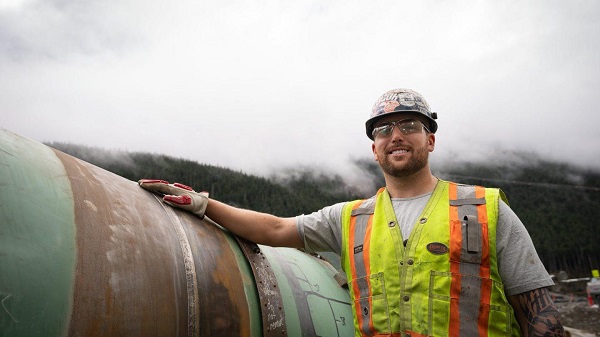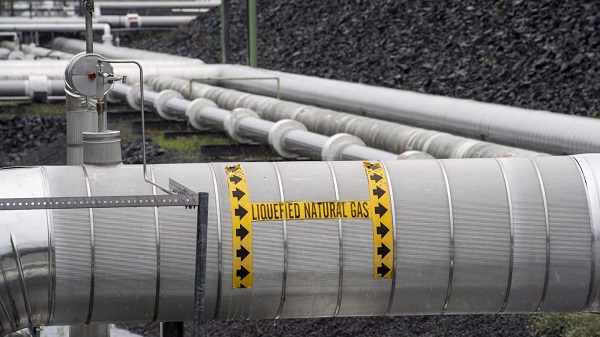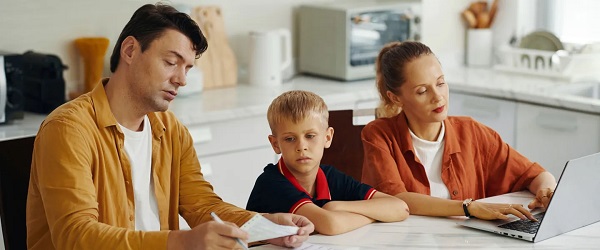Canadian Energy Centre
Completing Trans Mountain, Indigenous LNG: What to watch in Canadian energy in 2024

Workers lay pipe during construction of the Trans Mountain pipeline expansion on farmland in Abbotsford, B.C., on May 3, 2023. CP Images photo
From the Canadian Energy Centre
By Deborah JaremkoActivity promises to highlight Canada’s position as a world supplier of choice
It’s going to be a big year for Canadian energy, with major milestones anticipated that will transform Canada from a supplier with a single customer (the United States) to a global player.
Global demand for oil and gas is expected to stay strong in the decades ahead as the world works to reduce emissions, still supplying nearly half of energy needs in 2050, according to the International Energy Agency.
Activity in 2024 promises to highlight Canada’s position as a supplier of choice with a leading approach to reducing emissions and engaging Indigenous communities.
Here are five things to watch.
5. Start-Up Activities for LNG Canada

Construction of the LNG Canada export terminal is now more than 90 per cent complete. Photo courtesy LNG Canada
Against the backdrop of surging liquefied natural gas (LNG) demand – Asia’s consumption hit a record 26.6 million tonnes in December – Canada’s first LNG export terminal is preparing for start-up.
LNG Canada will have among the world’s lowest emissions for LNG supply, at 0.15 tonnes of CO2 equivalent per tonne of LNG, less than half the global average.
This year, the terminal at Kitimat, B.C. will test and fine-tune equipment and the process of producing LNG will begin, the company says.
The start-up program will take more than one year to complete.
Moving into the final stages at LNG Canada follows the recent completion of the Coastal GasLink Pipeline, connecting natural gas supply from northeast B.C.
4. Progress Toward Oil Sands Net Zero

The Pathways Alliance has extensive work underway on the environmental program for its proposed CCS project, involving 135 experts ranging from aquatic and wildlife biologists to archeologists and paleontologists who have spent more than 1,600 hours in the field working to minimize environmental disturbance. Photo courtesy Pathways Alliance
Major regulatory applications are expected in 2024 for one of the world’s largest proposed carbon capture and storage (CCS) networks, located in Canada’s oil sands.
The project would connect CO2 captured at an initial 14 oil sands facilities by pipeline to a shared hub for storage deep underground.
It is the foundation of the plan by the Pathways Alliance – companies representing 95 per cent of oil sands production – to reduce emissions from operations by nearly one third by 2030 on the way to net zero by 2050.
Pathways has said that after regulatory approvals are complete, CO2 injection and storage could begin by late 2026.
3. Growth in Indigenous Ownership

Eva Clayton, back left, President of the Nisga’a Lisims Government (joint venture owner of the proposed Ksi Lisims LNG project), Crystal Smith, back right, Haisla Nation Chief Councillor (joint venture owner of proposed Cedar LNG project), and Karen Ogen, front right, CEO of the First Nations LNG Alliance pose for a photograph on the HaiSea Wamis zero-emission tugboat outside the LNG2023 conference, in Vancouver, B.C., Monday, July 10, 2023. CP Images photo
The rising tide of Indigenous ownership in Canadian energy is likely to continue growing in 2024.
From LNG terminals to oil and gas pipelines, natural gas-fired power plants and CCS projects to reduce emissions, more Indigenous communities are taking on a leadership role.
Since 2022, more than 75 First Nations and Métis communities in Alberta and British Columbia have agreed to ownership stakes in energy projects including the Coastal GasLink pipeline and major oil sands transportation networks.
Indigenous loan guarantee programs like those offered by the Alberta Indigenous Opportunities Corporation (AIOC) are helping communities invest.
So far, the AIOC has underwritten more than $500 million in loan guarantees. This year it has $3 billion of support available, up from $2 billion in 2023.
Details of a proposed national loan guarantee program to help facilitate Indigenous equity ownership in major resource projects are also expected in the federal budget this spring.
2. Green Light for Cedar LNG
Owners of the world’s first Indigenous-led LNG project – a floating terminal at Kitimat, B.C. –plan to make the final decision to proceed within the next three months.
Cedar LNG, owned jointly by the Haisla Nation and Pembina Pipeline Corporation, would have capacity to export three million tonnes of LNG per year, primarily to Asian markets.
With emissions intensity of 0.08 tonnes of CO2 equivalent per tonne of LNG, it would be one of the lowest carbon footprint LNG projects in the world.
In early January, the partners reached the critical milestone of selecting the primary contractors to engineer, build and deliver the floating LNG unit.
A final investment decision is now expected in the first quarter of 2024.
1. Completion of the Trans Mountain Pipeline Expansion
After more than 12 years in the making, Canada’s first large-scale access to growing global oil markets is now weeks away from completion.
The existing Trans Mountain pipeline system from Edmonton, Alberta to Burnaby, B.C. runs consistently at maximum capacity with producers seeking more export space than is available.
The expansion will increase service by about 600,000 barrels per day, bringing more Canadian oil to customers around the world, primarily on the U.S. west coast and Asia.
After the recent resolution of a regulatory delay, Trans Mountain can now proceed with the last two per cent of construction.
The company anticipates oil will flow on the expanded line before the end of March.
2025 Federal Election
Canada’s pipeline builders ready to get to work

From the Canadian Energy Centre
“We’re focusing on the opportunity that Canada has, perhaps even the obligation”
It was not a call he wanted to make.
In October 2017, Kevin O’Donnell, then chief financial officer of Nisku, Alta.-based Banister Pipelines, got final word that the $16-billion Energy East pipeline was cancelled.
It was his job to pass the news down the line to reach workers who were already in the field.
“We had a crew that was working along the current TC Energy line that was ready for conversion up in Thunder Bay,” said O’Donnell, who is now executive director of the Mississauga, Ont.-based Pipe Line Contractors Association of Canada (PLCAC).
“I took the call, and they said abandon right now. Button up and abandon right now.
“It was truly surreal. It’s tough to tell your foreman, who then tells their lead hands and then you inform the unions that those three or four or five million man-hours that you expected are not going to come to fruition,” he said.

Workers guide a piece of pipe along the Trans Mountain expansion route. Photograph courtesy Trans Mountain Corporation
“They’ve got to find lesser-paying jobs where they’re not honing their craft in the pipeline sector. You’re not making the money; you’re not getting the health and dental coverage that you were getting before.”
O’Donnell estimates that PLCAC represents about 500,000 workers across Canada through the unions it works with.
With the recent completion of the Trans Mountain expansion and Coastal GasLink pipelines – and no big projects like them coming on the books – many are once again out of a job, he said.
It’s frustrating given that this could be what he called a “golden age” for building major energy infrastructure in Canada.
Together, more than 62,000 people were hired to build the Trans Mountain expansion and Coastal GasLink projects, according to company reports.
O’Donnell is particularly interested in a project like Energy East, which would link oil produced in Alberta to consumers in Eastern and Atlantic Canada, then international markets in the offshore beyond.
“I think Energy East or something similar has to happen for millions of reasons,” he said.
“The world’s demanding it. We’ve got the craft [workers], we’ve got the iron ore and we’ve got the steel. We’re talking about a nation where the workers in every province could benefit. They’re ready to build it.”

The “Golden Weld” marked mechanical completion of construction of the Trans Mountain Expansion Project on April 11, 2024. Photo courtesy Trans Mountain Corporation
That eagerness is shared by the Progressive Contractors Association of Canada (PCA), which represents about 170 construction and maintenance employers across the country.
The PCA’s newly launched “Let’s Get Building” advocacy campaign urges all parties in the Canadian federal election run to focus on getting major projects built.
“We’re focusing on the opportunity that Canada has, perhaps even the obligation,” said PCA chief executive Paul de Jong.
“Most of the companies are quite busy irrespective of the pipeline issue right now. But looking at the long term, there’s predictability and long-term strategy that they see missing.”
Top of mind is Ottawa’s Impact Assessment Act (IAA), he said, the federal law that assesses major national projects like pipelines and highways.
In 2023, the Supreme Court of Canada found that the IAA broke the rules of the Canadian constitution.
The court found unconstitutional components including federal overreach into the decision of whether a project requires an impact assessment and whether a project gets final approval to proceed.
Ottawa amended the act in the spring of 2024, but Alberta’s government found the changes didn’t fix the issues and in November launched a new legal challenge against it.
“We’d like to see the next federal administration substantially revisit the Impact Assessment Act,” de Jong said.
“The sooner these nation-building projects get underway, the sooner Canadians reap the rewards through new trading partnerships, good jobs and a more stable economy.”
Canadian Energy Centre
First Nations in Manitoba pushing for LNG exports from Hudson’s Bay

From the Canadian Energy Centre
By Will Gibson
NeeStaNan project would use port location selected by Canadian government more than 100 years ago
Building a port on Hudson’s Bay to ship natural resources harvested across Western Canada to the world has been a long-held dream of Canadian politicians, starting with Sir Wilfred Laurier.
Since 1931, a small deepwater port has operated at Churchill, Manitoba, primarily shipping grain but more recently expanding handling of critical minerals and fertilizers.
A group of 11 First Nations in Manitoba plans to build an additional industrial terminal nearby at Port Nelson to ship liquefied natural gas (LNG) to Europe and potash to Brazil.
Robyn Lore, a director with project backer NeeStaNan, which is Cree for “all of us,” said it makes more sense to ship Canadian LNG to Europe from an Arctic port than it does to send Canadian natural gas all the way to the U.S. Gulf Coast to be exported as LNG to the same place – which is happening today.
“There is absolutely a business case for sending our LNG directly to European markets rather than sending our natural gas down to the Gulf Coast and having them liquefy it and ship it over,” Lore said. “It’s in Canada’s interest to do this.”
Over 100 years ago, the Port Nelson location at the south end of Hudson’s Bay on the Nelson River was the first to be considered for a Canadian Arctic port.
In 1912, a Port Nelson project was selected to proceed rather than a port at Churchill, about 280 kilometres north.
The Port Nelson site was earmarked by federal government engineers as the most cost-effective location for a terminal to ship Canadian resources overseas.
Construction started but was marred by building challenges due to violent winter storms that beached supply ships and badly damaged the dredge used to deepen the waters around the port.
By 1918, the project was abandoned.
In the 1920s, Prime Minister William Lyon MacKenzie King chose Churchill as the new location for a port on Hudson’s Bay, where it was built and continues to operate today between late July and early November when it is not iced in.
Lore sees using modern technology at Port Nelson including dredging or extending a floating wharf to overcome the challenges that stopped the project from proceeding more than a century ago.
He said natural gas could travel to the terminal through a 1,000-kilometre spur line off TC Energy’s Canadian Mainline by using Manitoba Hydro’s existing right of way.
A second option proposes shipping natural gas through Pembina Pipeline’s Alliance system to Regina, where it could be liquefied and shipped by rail to Port Nelson.
The original rail bed to Port Nelson still exists, and about 150 kilometers of track would have to be laid to reach the proposed site, Lore said.
“Our vision is for a rail line that can handle 150-car trains with loads of 120 tonnes per car running at 80 kilometers per hour. That’s doable on the line from Amery to Port Nelson. It makes the economics work for shippers,” said Lore.
Port Nelson could be used around the year because saltwater ice is easier to break through using modern icebreakers than freshwater ice that impacts Churchill between November and May.
Lore, however, is quick to quell the notion NeeStaNan is competing against the existing port.
“We want our project to proceed on its merits and collaborate with other ports for greater efficiency,” he said.
“It makes sense for Manitoba, and it makes sense for Canada, even more than it did for Laurier more than 100 years ago.”
-

 2025 Federal Election1 day ago
2025 Federal Election1 day agoOttawa Confirms China interfering with 2025 federal election: Beijing Seeks to Block Joe Tay’s Election
-

 Energy2 days ago
Energy2 days agoIndigenous-led Projects Hold Key To Canada’s Energy Future
-

 2025 Federal Election1 day ago
2025 Federal Election1 day agoHow Canada’s Mainstream Media Lost the Public Trust
-

 Energy2 days ago
Energy2 days agoMany Canadians—and many Albertans—live in energy poverty
-

 2025 Federal Election18 hours ago
2025 Federal Election18 hours agoBREAKING: THE FEDERAL BRIEF THAT SHOULD SINK CARNEY
-

 Business2 days ago
Business2 days agoCanada Urgently Needs A Watchdog For Government Waste
-

 2025 Federal Election1 day ago
2025 Federal Election1 day agoReal Homes vs. Modular Shoeboxes: The Housing Battle Between Poilievre and Carney
-

 International2 days ago
International2 days agoPope Francis has died aged 88










